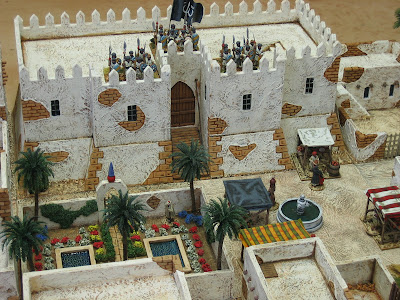My Middle Eastern building collection has grown over the years. Originally designed as generic buildings for use with my Crusades collection it will now also serve for my colonial adventures in the Sudan.
Funnily enough, I have little idea of what buildings looked like in the Holy Land in the 12th century and I've only seen a few images of Victorian era buildings in the Sudan. However, these buildings somehow look right for both, even if they are probably not: I put this down to most Middle Eastern wargame buildings looking like this (flat roof with parapet) and this familiarity has, as is often the case, bred a contempt for anything more 'historically accurate'.
Each 'town section' is on a 21cm square base. They would be better on 20cm square bases, to go with my To The Strongest rules table grid, but that did not allow enough room to build enough space to house my troops - each has a capacity of two units. Some of the sections have been designed with attached streets to make a workable road network. Most of the sections have buildings in a self contained compound - a feature common in the Middle East. This compound design allows for my town to be fully enclosed, without the need of separate town walls, and accessible only at town gates; the town gates are separate features that can be removed. So far, I have 14 town sections.The largest building is the Emir's Palace. Effectively, it is two sections; it serves as the town's / governor's 'citadel' with a reasonable table footprint.
Unlike most of my buildings this one has moving parts - the drawbridge works!
A very simple town section is the market. This is simply a textured base with movable stalls and fountain. Effectively, it is also a very useful 'crossroads' connector piece.
To look after the spiritual side of town life there is a small mosque and minaret.
A very simple town section is the market. This is simply a textured base with movable stalls and fountain. Effectively, it is also a very useful 'crossroads' connector piece.
To look after the spiritual side of town life there is a small mosque and minaret.
The dome and stepped platform on the mosque roof can be removed for the deployment of troops. It has a central locator pin to keep it in position.
At some point I'm going to make a bigger mosque.
Another simple town section, with a bit of difference about it, is this ornamental garden. The shrubbery is made out of Woodland Scenic clumps - the low hedging has been flocked, the flowers are painted clumps. Everything is at more or less the same low level so that troops can be placed on top.
Some sections are usable in more than one way. This one, with a central road 'T' junction, has a moveable wall to enclose the piece when on the outside of the town...
When on the inside the central road can lead to a compounds centrally located gate.
Most of the buildings are simple one or two story affairs and often mixed on a base to make the whole look a bit 'jumbled'.
The amount of broken plaster, showing underlying brick work, came about after reading of the decrepit state of the villages in the 12th century Holy Land following steady depopulation over the previous four centuries: it seems that there simply wasn't enough manpower to repair anything!
Another simple town section, with a bit of difference about it, is this ornamental garden. The shrubbery is made out of Woodland Scenic clumps - the low hedging has been flocked, the flowers are painted clumps. Everything is at more or less the same low level so that troops can be placed on top.
Some sections are usable in more than one way. This one, with a central road 'T' junction, has a moveable wall to enclose the piece when on the outside of the town...
When on the inside the central road can lead to a compounds centrally located gate.
Most of the buildings are simple one or two story affairs and often mixed on a base to make the whole look a bit 'jumbled'.
The amount of broken plaster, showing underlying brick work, came about after reading of the decrepit state of the villages in the 12th century Holy Land following steady depopulation over the previous four centuries: it seems that there simply wasn't enough manpower to repair anything!
The palm trees are not fixed but, they add to the hot dry feel of the place.
Another shot. The town is 84cm wide and 84cm deep at it's widest points.
Another shot. The town is 84cm wide and 84cm deep at it's widest points.
All of the buildings were scratch made using 5mm foam board, 2mm MDF (especially the bases), and card (mounting and old postcards, the latter used to make the brickwork). Doors, trapdoors and main gates are balsa. Grilled gates are plastic (cut up plastic bases by Perry).
Plasterwork is mostly artist's (tubed) heavy body acrylic.











